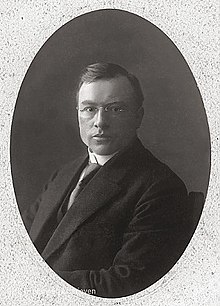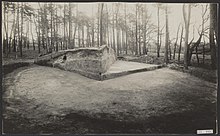Albert van Giffen
Albert Egges van Giffen (born March 14, 1884 in Zuidhorn -Noordhorn, † May 31, 1973 in Zwolle ) was a Dutch archaeologist , botanist and zoologist .
life and work
Albert Egges van Giffen was born on March 14, 1884 in Noordhorn, a village in the municipality of Zuidhorn in the Dutch province of Groningen, to the preacher Jan van Giffen and the Hendrika Postborn. He attended high schools in Sneek and Zutphen and began to study botany and zoology at the University of Groningen after graduating from high school in 1904 . In 1910 he received his doctorate cum laude with a thesis on the fauna of the Wurten , to which he had previously worked as an assistant at the Centraal Bureau voor de kennis van de provincie Groningen en om Genealogie ("Central Office for Knowledge of the Province of Groningen and the Surrounding Area ") over the years 1908 to 1910 had suggested. After a further period of assistance in the zoological laboratory in Groningen (1911–1912), he became curator of the Rijksmuseum van Oudheden in Leiden in 1912 , a position he held until 1917.
Conflict with Jan Hendrik Holwerda
Immediately after starting this activity, he worked on the excavation campaigns that Jan Hendrik Holwerda carried out between 1908 and 1915 in Leidschendam-Voorburg , which at that time had not yet been identified as Forum Hadriani . Through Holwerda he learned the German excavation methodology, in which soil traces / soil discoloration were observed and documented. This method made it possible to understand the construction of wooden buildings that were already completely in ruins. Technical differences soon developed between the two researchers. It is possible that the practitioner Van Giffen was soon on a par with his teacher Holwerda, who was more of a theorist in this field. He was also considered ambitious and perhaps focused too much on his own career in Dutch archeology. In any case, the conflict between the two researchers became so acute that even an intervention by the then Dutch Prime Minister Pieter Cort van der Linden was unable to settle the dispute, so that the scientists, who were among the most important Dutch archaeologists of their time, no longer communicated with each other.
From Leiden back to Groningen
In 1917 Van Giffen left Leiden University and Holwerda and returned to Groningen as curator of the zoological laboratory. His further activities there led in 1920 to the establishment of the BAI Biological-Archaeological Instituut van de Rijksuniversiteit Groningen ("Biological-Archaeological Institute of the Reich University of Groningen"), which he took over in 1928.
"Father of the barrows" and the Ezinge job creation scheme
In 1919 Van Giffen was commissioned by the government to write a report on the situation of the Dutch dolmens . Over several years of work, all grave mounds were measured and documented photographically and textually. The result of this major project was Van Giffen's best-known, three-volume publication De Hunebedden in Nederland , which was published in full by 1927 . This company, as well as the fact that the dolmens remained one of Van Giffen's main focuses, earned him the very appreciative nickname Vader van de hunebedden ("Father of the barrows"). In 1930 another publication with the title Die Bauart der Einzelgräber rounded off the standard work. Van Giffen was the first to use a form of the quadrant method developed by Mortimer Wheeler for large-scale investigations as the standard ( also called "Wheeler-Kenyon method" after Wheeler and the British archaeologist Kathleen Kenyon ) with offset crossbars. This enabled the plan and the profiles to be examined in their mutual spatial relationship. Here, too, his methodology differed from that of Holwerda, who preferred to cut burial mounds using narrow, mostly T-shaped trenches.
The consequences of the Great Depression of 1929 and the resulting job creation measures made it possible for Van Giffen to tackle other larger projects. A site near the village of Ezinge in the municipality of Winsum , which he had noticed for a long time , was turned into a major archaeological job creation project between 1931 and 1934, in which a settlement continuity between 500 BC and 2000 years was established. Chr. And 1500 AD could be detected.
Occupation and post-war activities
In 1932 Van Giffen became a member of the Royal Academy of Sciences in Amsterdam. In 1939 he became associate professor for prehistory and Germanic archeology at Groningen University, and in 1943 full professor. Although he is described as an apolitical person and alien to theorizing, he used the opportunities offered by the German occupation forces to carry out emergency excavations , for example in Havelte and Zeijen , a village in the municipality of Tynaarlo in the province of Drenthe . As early as 1941 he was appointed associate professor at the Universiteit van Amsterdam by resolution of the city council , but in 1943 he resigned from this office. However, under changed political conditions, after the liberation, he was re-elected as associate professor in Amsterdam in 1946.
After 1945 he promoted palynology in archaeological contexts. In 1947 he became the first head of the Rijksdienst für Oudheidkundig Bodemonderzoek ("Reichsdienst für Altertumswissliche Bodenuntersuchungen"), the predecessor organization of today's Rijksdienst voor het Cultureel Erfgoed ("Reichsdienst for the cultural heritage") based in Amersfoort . Finally in 1951 he succeeded in founding an institute for prehistory at the University of Amsterdam. In the 1950s he was one of the first Dutch archaeologists to devote himself to city core archeology (specifically in Amsterdam and Groningen). Overall, however, in the years between the end of the war in 1945 and his retirement in 1954, more archaeologists became active in the Netherlands, some of whom had been trained by him or his contemporary colleagues. Corresponding scientific disputes were the order of the day. Van Giffen showed one last time that a personality like him was difficult to share his importance in Dutch archeology with others or even to leave it to others. In this way he succeeded in ensuring that after his retirement he was appointed Rijksadviseur voor de bescherming en de instandhouding van de hunebedden en de gerestaureerde archeologische monumenten ("Government advisor for the protection and preservation of dolmens and restored archaeological monuments").
Private life, death and aftermath
On December 15, 1911, Van Giffen married Klaziena Geertruida Homan, with whom he had two daughters and two sons, before the marriage was divorced on July 12, 1938. A second marriage to Guda Erica Gerharda Duijvis on November 30, 1938, remained childless.
Van Giffen died in Zwolle on March 31, 1973. He bequeathed his collections to the Rijksuniversiteit Groningen. The Institute for Prehistory and Protohistory at the University of Amsterdam was named after him Albert Egges van Giffen Instituut voor Pre- en Protohistorie (Universiteit van Amsterdam) .
Fonts (selection)
- Het dalingsvraagstuk the alluvial North Sea coast, in association with bestudeering the terpen . Noordhoff, Groningen 1910.
- Fauna of the Wurten . Brill, Leiden 1913
- De hunebedden in Nederland. Volume 1, Oosthoek, 1925.
- De hunebedden in Nederland. Volume 2, Oosthoek, 1926.
- De hunebedden in Nederland. Volume 3, Oosthoek, 1927.
- The design of the individual graves. Contribution to the knowledge of the older individual burial mound structures in the Netherlands (= Mannus Library Volume 44). Kabitzsch, Leipzig 1930.
- The Throw in Ezinge, Groningen Province, Holland, and its West Germanic houses . In: Germania. Gazette of the Roman-Germanic Commission of the German Archaeological Institute 20, 1936, pp. 40–47.
- Oudheidkundige aanteekeningen over Drentsche vondsten (IV) . Van Gorum-Aan den Brink, 1937.
- Tumuli-Opgravingen in Gelderland, 1935/36 . Gouda Quint, Arnhem 1937.
- Continental Bell-or Disc-Barrows in Holland with special reference to Tumulus I at Rielsch Hoefke . (= Proceedings of the Prehistoric Society Vol. 4, No. 2). Cambridge University Press, Cambridge 1938.
- Opgravingen in Drente dead in 1941 . Boom & Zoon, 1943.
- with Johannes Gerritsen and Willem Glasbergen : De romeinsche castella in den dorpsheuvel te Valkenburg aan den Rijn (ZH). (Praetorium Agrippinae) . Vol. 1, Wolters, Groningen 1945.
- Het Noordse Veld bij Zeijen, Gemeente Vries. Opgravingen in 1944. In: Nieuwe Drentsche Volksalmanak 67, 1949, pp. 93-148.
- Prehistoric house shapes on sandy soils in the Netherlands. In: Germania. Gazette of the Roman-Germanic Commission of the German Archaeological Institute 36, 1958, pp. 35–71.
- with Willem Glasbergen : De vroegste faze van de TRB-cultuur in Nederland . In: Helinium 4 , 1964, pp. 40-48.
literature
- Jan Albert Bakker: The TRB Westgroup. Studies in the Chronology and Geography of the Makers of Hunebeds and Tiefstich Pottery. Amsterdam, 1979/2009. Sidestone Press, Leiden 2009.
- Jan Albert Bakker: Megalithic Research in the Netherlands, 1547-1911. From 'Giant's Beds' and 'Pillars of Hercules' to accurate investigations . Sidestone Press, Leiden 2010.
- JA Brongers: Giffen, Albert Egges van (1884–1973) . In: Biografisch Woordenboek van Nederland Volume 3. The Hague 1989 ( digitized version ).
- Albert Genrich : The working group for Saxony research. Origin, development and tasks . In: Fornvännen. Journal of Swedish Antiquarian Research 81, 1986, pp. 40-46 ( digitized version ).
- Hermann Schwabedissen : Albert Eggers van Giffen, Zwolle / Netherlands March 14, 1884 - May 31, 1973 . In: Archäologische Informations 4/1978, p. 206f. ( Digitized version ).
- Pieter van der Velde: A short history of Dutch archeology . Leiden University, Leiden 1994 ( digitized version ).
- Leo BM Verhart: A monument voor de archeologie, a monument voor zichzelf. Het hunebeddenboek van AE van Giffen . In: Nieuwe Drentse Volksalmanach 2016, pp. 187–220 ( digitized version ).
- HI Waterbolk: Albert Egges van Giffen (Noordhorn 14 May 1884 – Zwolle 31 May 1973) . In: Jaarboek van de Maatschappij der Nedertandse Letterkunde te Leiden 1976 (1977), pp. 122-153 ( digitized version ).
Web links
- Albert van Giffen (1884–1973), archaeologist on the website of the University of Groningen, accessed on October 19, 2018
- estate
Individual evidence
- ↑ Fauna of the Wurten . Brill, Leiden 1913.
- ↑ a b c d e JA Brongers: Giffen, Albert Egges van (1884-1973) . In: Biografisch Woordenboek van Nederland Volume 3. The Hague 1989 ( digitized version ).
- ^ Evert van Ginkel and Wouter Vos: Grens van het Romeinse Rijk. De Limes in Zuid-Holland . Matrijs, Utrecht 2018, ISBN 978-90-5345-531-9 , pp. 74-79.
- ^ Albert van Giffen: De hunebedden in Nederland . 3 volumes, Oosthoek, 1925 to 1927.
- ↑ Albert van Giffen: The construction of the individual graves. Contribution to the knowledge of the older individual burial mound structures in the Netherlands . Vol. 44, Kabitzsch, 1930.
- ^ Albert van Giffen: Het Noordse Veld bij Zeijen, Gemeente Vries. Opgravingen in 1944. In: Nieuwe Drentsche Volksalmanak 67, 1949, pp. 93-148.
- ↑ Kirsten van der Ploeg and Piet Kooi: Ezinge. IJkpunt in de archeologie . Forsten, Groningen 2014.
- ↑ Annet Nieuwhof: De geschiedenis van Ezinge in scherven. Handged aardewerk van 500 BC to 1500 AD In: Dies .: En dan in hun geheel. De vondsten uit de opgravingen in de wierde Ezinge . Vereniging voor Terpenonderzoek, Groningen 2014, pp. 30–128.
- ^ Albert van Giffen: De Havelterberg en omgeving bij Havelte, gem. Havelte. Opgravingen in 1943 . (1944).
- ↑ Albert van Giffen: De nederzettingsoverblijfselen in het Bolleveen en de versterking, de zgn. “Legerplaats” aan het Witteveen op het Noordse Veld, both at Zeijen, Gem. Vries. In: Nieuwe Drentse Volksalmanak 68, 1950, pp. 89–123.
- ↑ Willy Groenman-Van Waateringe and Carol Van Driel-Murray: Are We Too Loud? . IPP publicatie 246, Council for British Archeology, 1979.
| personal data | |
|---|---|
| SURNAME | Giffen, Albert van |
| ALTERNATIVE NAMES | Giffen, Albert Egges van (full name) |
| BRIEF DESCRIPTION | Dutch archaeologist, botanist and zoologist |
| DATE OF BIRTH | March 14, 1884 |
| PLACE OF BIRTH | Noordhorn |
| DATE OF DEATH | May 31, 1973 |
| Place of death | Zwolle |

